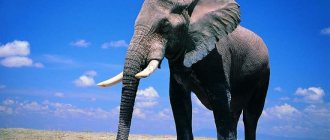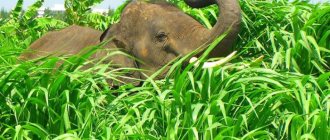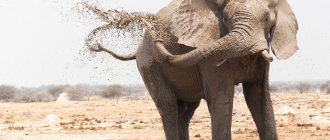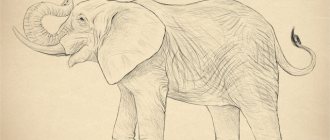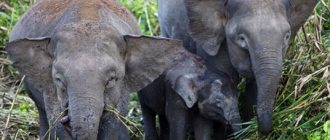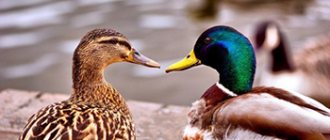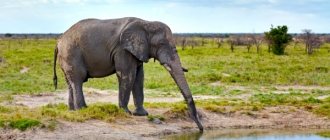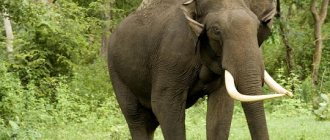Elephants are large herbivorous mammals from the order Proboscis. All living species of elephants belong to the elephant family. The first primitive ancestors of modern proboscideans, the skeletons of which were found in Africa, appeared more than 50 million years ago. These were relatively small animals (maximum weight - 300 kg) with a just developing trunk and small tusks. Meriteria and Deinotherium, which appeared 10-20 million years ago, already had a visible trunk formed from the nose and upper lip. The closest in terms of evolution to the proboscis family are mastodons and mammoths, which became extinct about 10 thousand years ago.
The origin of the word elephant is not known for certain. According to one version, it is a modified form of the Turkic word arslan, which means lion, that is, a very large and strong animal. Another hypothesis for the etymology of the name is related to the fact that the animal sleeps standing, leaning against a tree or other support.
Characteristics and description of the animal
Elephants are the largest land mammals. The way of life of animals has its own characteristics. They live in large groups, in which the oldest and most experienced female dominates. Typically, a herd of elephants consists of related females and their calves. Sexually mature males live either alone or form small groups.
An elephant's brain weighs 7 kg. This is not so much, considering the weight of the animal. However, elephants have a fairly developed intelligence and good visual memory. Their vision is not very well developed, but their hearing is many times superior to that of humans, and their excellent sense of smell allows them to distinguish odors whose source is located several kilometers away.
Animals have the ability to thermoregulate. On hot days, the elephant's body temperature decreases due to the flapping of its ears, riddled with blood vessels. The blood cooled in this way returns to the body, maintaining a stable body temperature at +36 degrees.
Elephants can swim, covering distances of several tens of kilometers, and walk underwater, raising their trunk to the surface.
Adult elephants have no natural enemies. Only fragile elephant calves under 2 years of age suffer from attacks by predators. Large cats, crocodiles and packs of hyenas can attack them.
What sounds does an elephant make?
What does it look like
The characteristic features of the appearance of elephants are as follows:
| Body | Large, short, tail almost equal in length to the hind limbs |
| Head | Large, round, small eyes, nose and upper lip form a long trunk, adults have tusks |
| Ears | Large, rectangular or triangular in shape |
| Legs | Thick and massive, slightly expanding at the bottom, in the center of the foot there is a fat pad that serves as a shock absorber |
| Color | Shades of gray and brown |
Dimensions and weight
The average weight of a newborn elephant is 100 kg. Animals continue to grow until they reach sexual maturity, and gain weight until they are 20-25 years old. The maximum weight of an elephant and its height at the withers depends on the variety. The largest representatives of the family are the inhabitants of Africa, whose weight reaches 6-8 tons or more, and their height is 4 m.
Tusks
In elephants, tusks were formed as a result of elongation of the lateral incisors of the upper jaw. They grow throughout life, which makes it possible to determine the age of the animal. The weight of tusks in old males can reach 90 kg.
Nutrition in captivity
Wild Indian or Asian elephants are currently endangered and are often kept in protected areas or zoological parks. In nature and in captivity, elephants live in complex social groups, within which strong bonds are observed, which facilitates the process of obtaining food and feeding the animals. When kept in captivity, the mammal receives a huge amount of greenery and hay. The daily diet of such a large herbivore is necessarily supplemented with root vegetables, dried loaves of white bread, carrots, cabbage heads and fruits.
This is interesting! The Indian and African elephant's favorite treats include bananas, as well as low-calorie cookies and other sweets.
It should be noted that elephants do not know moderation when it comes to eating sweets, so they are prone to overeating and rapid weight gain, which has an extremely negative impact on the health of the animal. In this case, the proboscis animal acquires unnatural behavior, characterized by an unsteady gait or apathy with loss of appetite.
It is important to remember that elephants living in natural conditions move a lot and are very active . To find enough food to preserve life and maintain health, the mammal is able to travel a considerable distance every day. In captivity, the animal is deprived of this opportunity, so quite often elephants in zoos have problems with weight or the digestive system.
In a zoo, an elephant is fed approximately five or six times a day, and the daily diet of a mammal in the Moscow Zoological Park consists of the following staple foods:
- brooms from tree branches - approximately 6-8 kg;
- grass and hay with straw additives - approximately 60 kg;
- oats – about 1-2 kg;
- oatmeal – about 4-5 kg;
- bran – approximately 1 kg;
- fruits, represented by pears, apples and bananas - about 8 kg;
- carrots – about 15 kg;
- cabbage – about 3 kg;
- beets - approximately 4-5 kg.
The elephant's summer-autumn menu necessarily includes watermelons, as well as boiled potatoes. All fruits and vegetables given to the mammal are cut quite carefully, and then mixed well with grass meal or lightly chopped high-quality hay and straw. The resulting nutrient mixture is scattered over the entire area of the enclosure.
This method of feeding allows the animals to actively move in search of the most delicious pieces of food, and also significantly reduces the rate at which elephants absorb food.
Return to content
Types of elephants
The elephant family includes several species that have certain differences in appearance and size.
African
The species unites elephants living on the African continent. All of them are characterized by the rectangular shape of their ears, the size of which is noticeably larger than those of Asian ears. Another feature of the species is the presence of two grasping fingers on the trunk. In the taxonomy there are two separate subspecies: forest and savannah. Let's take a closer look at the second of them.
Savannah
Of all the representatives of the family, savannah elephants are the largest and most massive. This is perhaps the only subspecies that cannot be taught or trained.
Asiatic
Combines the Sumatran and Ceylon subspecies of elephants. The name of the varieties indicates the habitat of the populations. Characteristic features of these two subspecies are medium body size and the almost complete absence of tusks.
Bornean
A dwarf subspecies of the Asian elephant that lives on the island of Kalimantan. The Bornean elephant can be recognized by its very long and thick tail, as well as a noticeable hump at the withers.
Indian
The second largest elephant with a large body and relatively short legs. There are two characteristic bulges on the forehead. In the color of some individuals, unpigmented areas are noticeable. Albinos are found among Indian elephants.
Maltese dwarf
An extinct subspecies of the Asian elephant that once lived on the islands of the Mediterranean Sea. Restoration of the found skeletons of the animal indicates that their height did not exceed 1 m, and their weight did not exceed 300 kg.
How much food does an elephant need per day
The Indian or Asian elephant is predominantly a forest dweller, which makes the search and use of food somewhat easier. Such a large mammal prefers to live in light tropical and subtropical deciduous forests, characterized by the presence of a fairly dense undergrowth represented by various shrubby plants, including bamboo.
It should be taken into account that earlier, with the onset of the cool season, elephants could move en masse into the steppe zones, but now such movements have become possible only in nature reserves, which is due to the almost universal transformation of steppes into agricultural lands annually developed by humans.
In the summer, elephants move along forested slopes, heading to mountainous areas where the animal will be provided with sufficient food. However, due to its impressive size, the mammal needs an abundant food supply, so the process of feeding an elephant in one place rarely exceeds two or three days.
African and Asian elephants do not belong to the category of territorial animals, but they try to strictly adhere to the boundaries of their feeding area. For one adult male, the size of such a territory is about 15 km², and for gregarious females - within 30 km², but the boundaries can significantly increase in size in too dry and unproductive seasons.
The average amount of food eaten daily by an adult elephant is 150-300 kg, represented by a wide variety of plant foods, or approximately 6-8% of the total body weight of the mammal. To fully replenish minerals in the body, herbivores are able to look for the necessary salts in the ground.
Return to content
How do they reproduce?
Female elephants mature at the age of 11-14 years, their reproductive function remains up to 50 years. In males, puberty occurs by the age of 15 and is first manifested by the release of a sharp-smelling secretion from the temporal glands located between the eye and ear. Increased activity of the temporal glands indicates the beginning of must - the period when the male is ready to mate. It lasts on average about a month.
Must in elephants is accompanied by a significant increase in testosterone levels and frequent urination. Animals with a relatively calm character become aggressive. During this time, captive individuals are exempt from work or performance.
Elephant reproduction is not seasonal. Females, ready to mate, separate from the herd and emit calling calls. The mating season lasts about two weeks, after which the animals return to their groups.
How long does a mother elephant carry a baby elephant?
Pregnancy lasts 22 months, after which one baby elephant is born. The next time the elephant will be ready for mating only after 6-8 months.
Sometimes there are albinos among elephant calves. They are not completely white, but with a slightly pinkish or grayish tint. In Asia, albinos are still considered a symbol of royal power. The rulers of Thailand, Myanmar and other Asian countries have white elephants.
HIPPOPOTAMUS
Features of the absorption process
The elephant's digestive system has a number of features, and the absolute length of the entire digestive canal of this mammal is about thirty meters . All eaten vegetation first enters the animal’s oral cavity, where there are wide chewing teeth. Elephants are absolutely devoid of incisors and canines, which in such an animal are modified into large tusks that grow throughout life.
This is interesting! At birth, baby elephants have so-called milk tusks, which are replaced by permanent ones at the age of six months to a year, and the tusks of females are naturally characterized by very weak development or are absent altogether.
During the entire period of life, the elephant has six sets of molars with a rough surface, which is a necessary condition for thoroughly chewing roughage of plant origin. In the process of chewing food, the elephant quite actively moves its jaw back and forth.
As a result, well-chewed food, moistened with saliva, enters a fairly short esophagus, and then into a single-chamber stomach connected to the intestines. Fermentation processes occur inside the stomach, and part of the food is absorbed exclusively in the colon and cecum, under the influence of bacterial microflora. The average residence time of food in the gastrointestinal tract of a mammalian herbivore varies from one day to two days.
Return to content
Where do they live?
The habitat of elephants is the African continent and the southeastern part of Asia. In Africa, giants are found in many countries located south of the Sahara Desert. In Asia, the most numerous populations live in India, Thailand, China, and Malaysia.
The decline in elephant numbers in recent decades is caused by human economic activity and poaching for valuable tusks and meat. In order to preserve the population, the animal was included in the IUCN register, and numerous reserves were created in its habitats.
Where live
The elephant's natural habitat is savannas, tall grass meadows, and tropical forests. Animals are found in flat areas with sufficient food supply.
What color is the elephant?
Starting in Thailand, I believed that the zoo was deceiving us, and that elephants were actually not gray at all, but brown. Now I can slightly correct my observations. At the zoo, elephants are gray because they are not allowed to splash in the mud.
Interesting materials:
What is the name of a mythological creature that is similar in many ways to a dragon? What is the long-term weather pattern called? What is the name of the mod that shows crafting? What is the name of the mod for turning into mobs? What is the name of the mod for crafting recipes? What is the name of the cartoon Frozen? What is the name of the cartoon about two dogs? What is the name of the cartoon with the fairy Tinker Bell? What is the name of your sister's husband? What is the name of the owl's husband?
What do they eat?
Elephants need a lot of food. An adult animal can eat up to 300 kg of green mass per day. Food includes grass, leaves, young shoots, fruits and bark of trees and shrubs. Giants kept in captivity eat hay, grain, and a variety of vegetables and fruits.
Elephant calves that have just started eating solid food periodically eat the droppings of adult animals to obtain intestinal microflora. This makes it possible to get the maximum benefit from the herb for sustainable weight gain.
RHINOCEROS
In pursuit of food
Few people know that elephants eat for 17-19 hours a day. This is how long it takes them to satisfy their need for food. In the tropics, where the days are shorter than ours, proboscideans even have to spend several hours at night to get adequate nutrition. Animals wait out the heat of the day in water or in the shade so as not to overheat, and therefore lose precious time that they could spend on eating. During drought, elephants have to cross long distances every day between watering holes and pastures; they constantly move around the territory.
Why does an elephant need a trunk?
Among the ancient ancestors of the elephant, who were semi-aquatic animals, the trunk was used exclusively for breathing when immersed under water. Subsequently, it stretched out, the structure was supplemented by numerous groups of circular and longitudinal muscles, and a finger-like process formed at the end. All this significantly expanded the functionality of the trunk. With its help, the animal reaches tree branches and plucks grass. During a watering session, the elephant takes 6-7 liters of water inside and then pours it into its mouth. Using its trunk, the elephant trumpets - produces a characteristic roar, using its elongated nose as a wind instrument. When moving a herd over long distances, the babies usually follow the females and at the same time hold onto their tail with their trunks.
Lifestyle and behavioral characteristics
Unlike many animals of the African savannas and Asian jungles, which are active at night, elephants are diurnal. These giants do not have to fear attacks from enemies, so during daylight hours they constantly move from place to place in search of food.
And with the onset of dusk, the elephants go to bed for the night, posting several guards whose task is to notice in time the approach of predatory animals. The sentry shift lasts 4 hours, after which they are replaced by another group of sentries.
Huge and powerful elephants can afford a daily lifestyle
Members of the elephant clan huddle closely together at night, and the babies are placed between the adults. In this way, they protect elephant calves from hungry predators who can sneak up on the family under the cover of night and drag away the defenseless baby.
Interesting fact: Asian elephants sleep lying on their sides or stomachs, while their African relatives prefer to sleep in a standing position. Scientists explain this by saying that the soil in Africa gets hot every day under the scorching sun, and animals are simply afraid of overheating.
Elephant social structure
Gray giants live in small clans, numbering from 10 to 15 individuals. A real matriarchy reigns in the elephant community, and at the head of each group is a mature, experienced female. It is she who directs all the actions of the clan: she leads the herd to watering, finds new places for feeding and keeps order. The remaining members of the group are adult females, the younger generation and very young cubs.
Elephant family at a watering hole
There is complete love and mutual understanding in the elephant family. Everyone obeys the main elephant, and never tries to dislodge her from her leading position. When the leading female dies, the responsibility of head passes to her sister or daughter, and again, the change of power occurs peacefully, the clan unconditionally accepts the new leader, there are no offended or dissatisfied people in it.
Why are elephants afraid of mice?
Pliny the Elder mentioned that elephants hate mice in his Natural History, written more than 2000 years ago. However, experiments conducted by researchers and trainers of giant mammals refute this widely held belief. Most likely, a certain negative reaction to rodents is caused by their sudden movements. Elephants, who do not have very good eyesight, are unlikely to notice a mouse that sits motionless, but they immediately identify even small objects that move quickly and at the same time show concern.
Another version is that the rustling noise made by a running rodent resembles the sound of a creeping predator.
GIRAFFE
Diet
Everyone knows that currently there are two types of elephants - Indian and African. They are so different from each other that they can be considered representatives of different genera. So the diet of animals directly depends on the region where they live. For example, elephants living in southern India like to chew ficus leaves, while those living in Zimbabwe prefer to consume grasses like cattails and papyrus. What elephants eat also depends on the season: during rains and droughts, the diet will be different.
Interesting facts about elephants
- Elephants are slow animals. The speed of herds slowly walking in search of food or water reaches 3-5 km/h. Elephants can run, but they get tired very quickly. The maximum speed of an elephant is 40 km/h.
- Since 2011, the world has been celebrating International Elephant Day. As part of the celebration, which takes place on August 12, organizers disseminate information about the peculiarities of the animals' lifestyle and the need to protect them.
- The thickness of an elephant's skin reaches 2-4 cm, but the skin does not have sweat glands and is highly sensitive. The biggest inconveniences for giants are the scorching sun's rays and insects. To protect themselves from ultraviolet radiation and protect themselves from bites, elephants sprinkle sand on themselves after bathing. The resulting crust becomes a reliable protection for the skin of the mammal.
- The world's largest elephant was killed in Angola. The weight of the huge male exceeded 12 tons.
- Elephants communicate with each other using sounds, trunk waves, and posture changes. To transmit information to members of their herd located at a considerable distance, animals use low-frequency waves. The maximum distance at which elephants can hear their relatives is 10 km.
- Elephants are truly gigantic animals: the length of their trunk reaches 2 m, their tusks are 2.5 meters, the distance between the tips of their ears is 3 m, and their heart weighs 30 kg!
Fluid requirement
Proboscideans drink a lot (as already noted, up to 150 liters daily). If during a drought all available sources of water dry up, animals go in search of life-giving moisture. Using their trunks and tusks, they dig holes up to a meter deep in dry river beds, into which groundwater slowly flows. Other inhabitants of the savannah, unable to obtain drink in this way, patiently wait until the elephants quench their thirst, and then drink plenty themselves. Thus, proboscideans help them survive drought. However, it also happens that efforts to find water do not bring the desired result, and then hundreds, or even thousands of animals die from dehydration.
How do horses mate?
Mating of horses in nature or in free conditions occurs first with the courtship of a stallion. ... At this time, the stallion gets an erection and accepts the appropriate mating cage. Sexual intercourse itself in horses does not last long - usually a few minutes, after which sexual intercourse ends with the eruption of semen.
Interesting materials:
Which road is the main one in relation to the one you are crossing? What wood doesn't crack? What is the healthiest food? Which Olympic torch relay is considered the longest in history? What kind of fable is this? Even though he can see, he can't help but be numb? What was the European currency before the Euro? What is Eren's last name from Attack on Titan? What is the depth in the Yenisei? What is the tallest mountain in North America? Which hydrangea is the most unpretentious?
Types, photos and names
All elephants, depending on their habitat, are divided into African and Asian, moreover, African elephants, in turn, are divided into savannah and forest elephants, we will dwell on them in detail below.
Savannah elephant
This is the largest representative of the elephant family. It lives in African shrouds along the equator throughout Africa. It has a dark color, strong tusks and a process on the edge of the trunk.
forest elephant
This African elephant is slightly smaller than its savanna relative. Has rounded ears. Lives in tropical African forests.
Indian elephant
The Indian elephant, which lives in Asia, is the only representative of the elephant family in these places. Despite its name, the Indian elephant lives not only in India, but also in many other neighboring countries: Burma, Thailand, China, Cambodia, Laos, Vietnam, Brunei, Indonesia. The Indian elephant is smaller in size than the savannah elephant; its distinctive features are small quadrangular-shaped ears and a process at the end of the trunk.
And these elephants, unlike their African counterparts, were tamed by humans; since ancient times, rich Indian rajahs rode elephants, and warriors used elephants, including for combat purposes. In the wars of the ancient world, such a war elephant was similar to a modern tank.
Features of nutrition in the wild
Males consume up to 170 kilograms of fresh plants per day, while females are content with approximately 150 kilograms. Typically, proboscideans prefer vegetation that is located at a height of no more than two meters. The elephant will stretch its trunk higher only if the delicacy is really worth it; if necessary, it can stand up on its hind legs. Often young males will cut down small trees just for fun.
As we have already said, what elephants eat in Africa and what they eat in India differs significantly. For example, among savannah proboscideans from Uganda, up to 88 percent of the daily diet is grass, and Indian mammals consume mainly leaves, although they are also not averse to pampering themselves with tasty tubers and roots. As a rule, the elephant uproots the plant, shakes off the soil on its leg or tusk and puts the delicacy into its mouth.
